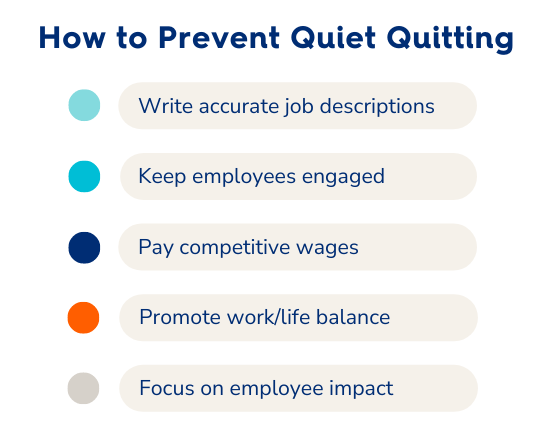A new workplace trend is quickly making its way around the internet – a term called “quiet quitting.”
Have you heard of it?
In most cases, quiet quitting refers to minimizing the amount of work you do at a job you dislike instead of leaving that job altogether. If you’re an employer, the last thing you want to hear is that your employees are intentionally doing the bare minimum.
But why has quiet quitting even gained so much steam?
Is it because workers are lazy or is there more to it than that?
Let’s talk about quiet quitting and how to prevent your team from joining in on the trend.
What is quiet quitting?
Quiet quitting refers to staying at your job, but on some level, minimizing the amount of work you’re doing. For some, this might mean doing the bare minimum at work. For others, it means no longer going above and beyond expectations or taking on additional work without additional pay.
Quiet quitting is rooted in social media and the conversations that happen on sites like TikTok, LinkedIn, Instagram and more. It’s hard to pinpoint where and how the term was coined, but it’s clear that many Millennial and Gen Z employees relate to its sentiment.
Gallup’s chief scientist for workplace and well-being research, Jim Harter, said that quiet quitting aligns with what he classifies as “not engaged” in the workplace. And Gallup recently found that more than half of workers born after 1989 fall into this category.
Before getting too riled up about this trend that seemingly encourages less effort from employees, it’s important to learn why people are doing this in the first place.
Typically, quiet quitting is a response to a job where an employee feels taken advantage of, underappreciated, and/or underpaid. It is a direct response to the “hustle culture” that for so long dominated the workplace. Instead of working insane hours to climb to the top, many younger employees are choosing to explore healthier relationships to work.
Clearly, you don’t want employees that are checked out, unengaged, or biding their time until their next opportunity. Regardless of how they define it, you don’t want your employees quiet quitting, and there are steps you can take as an employer to mitigate that concern.
How to prevent quiet quitting
This popular internet trend has sparked an important and necessary reevaluation of work for both employers and employees. Now’s the time to take a step back and consider how your company culture is holding up and whether you truly are creating a great place to work.
Let’s look at some actionable things you can do now to prevent quiet quitting on your team.

Write accurate job descriptions
One quick way to end up with frustrated employees is to assign them many tasks that they feel are outside of their initial job description.
It’s a tough balance, because you want to give people the opportunity to take on more and grow, but you also want to make sure that they feel like they have a say-so in the additional work added to their plate.
Did your newest waiter want to learn more about cooking food? Or did you just throw him in the kitchen during the rush of a Friday night dinner service?
Before you even make a hire, get clear on the specifics of what the role will entail. Try not to leave anything out. Write a clear and accurate job description that lines up with the actual day to day of the role.
Pro tip: It can be hard to know how a role might evolve and what extra responsibilities employees end up taking on within it. If you believe your employee’s role will need to expand to meet the needs of your business, consider finding a way to formally promote them (for example, giving them a “Senior” title to their current role) ideally with a raise to match the additional responsibilities. Consider it an investment in both the growth of your employee and the growth of your business.

Need some expert help writing your job descriptions?
Click the button below to receive free job description templates for common positions, all written by our team of hiring experts.
GET MY TEMPLATESKeep employees engaged
Engaging your employees can boost employee retention, decrease absenteeism, and improve productivity. In short, engaged employees are happy employees – employees that will be much less likely to quiet quit. Plus, one study of employee engagement found that 71% of managers believed that employee engagement is one of the most important factors contributing to overall company success.
Some ideas to keep your employees engaged?
- Set aside time for team-building activities separate from work like game nights, happy hours, workshops, and group lunches.
- Have a process for receiving feedback from employees.
- Give feedback regularly and recognize employees on an individual level.
- Have a clear mission and values. Share it with your team often so that employees feel like they are part of the bigger picture.
In a recent podcast appearance, CareerPlug president Jenny Leman, shared the importance of making individual employees feel seen and heard so that they are more connected to the workplace.
She says employers should ask themselves, “What are you building as your foundation for your employee to connect to you as an employer?”
Leman reminds employers that employee engagement starts with managers: “Employees want their managers to know them, to know what’s going on in their lives. Small connecting moments are really key for this younger workforce. It makes huge strides in how they respond to an employer.”
Pay competitive wages
For many employees, quiet quitting stems from not being paid enough for the amount of work they do. Minimizing their workload can make an employee feel more in control and like they’re getting paid more fairly. However, it’s likely just a temporary fix. In our 2022 Hourly Workers Compensation Report, we found that 55% of workers are looking for an opportunity to increase their pay, with 67% saying they’d even explore new industries or fields to do so.
So to prevent quiet quitting and well, actual quitting, it’s probably a good idea to take a look at how your compensation stacks up in your industry. Use resources on Indeed and Glassdoor to compare your compensation and adjust as necessary.
If offering raises isn’t feasible for you right now, keep in mind that many employees that aren’t satisfied with their pay are willing to accept benefits over increased compensation – 53% of them in fact! We found that some of the top benefits employees would accept are health insurance, more PTO, and professional development opportunities.
Promote work/life balance
Employee burnout refers to a psychological process in which employees are totally exhausted and stressed due to work. It can lead to feelings of depression and even cause physical sickness! It makes sense that quiet quitting would gain traction at a time when burnout is at an all-time high because it’s a logical response to burnout.
Employers should take burnout seriously and take steps to improve employee morale. One major contributing factor to employee burnout is a poor work/life balance. Plus, in our Toxic Work Environment Report, we found that “more work/life balance” was one of the most important changes employees would like to see made at work.
You might consider offering more paid time off or more flexible schedules. Remote working options can also give employees more flexibility and cut down on time-consuming commutes. Don’t create a culture where employees feel obligated to respond to emails outside of working hours or bring their laptops on vacation with them. If you find that mandatory overtime is a common occurrence, consider whether it might be time to make some new hires.
Be clear about each employee’s impact on the business
If quiet quitting involves doing the bare minimum in role, then as an employer, you need to ask yourself – what am I doing to motivate my people to want to contribute more than that?
Every person on your team should feel as though they have some skin in the game. What, specifically, are they doing to contribute to the business? What measurable impact are they having? Show them clearly, with real numbers. Reward them when their impact exceeds expectations.
Do you have a service technician on your team who has been completing more service calls than anyone else? Communicate that with the employee and with the entire team. Give people an opportunity – and a reason – to do more than the bare minimum. Recognition and esteem can go a long way.
Establishing measurable goals and communicating them regularly with your team increases transparency in the business. Plus, it gives them a better understanding of how the business operates. For many people, this kind of transparency can also double as a welcome learning opportunity, especially if they want to grow in the business.
Final thoughts
As Jenny Leman sums up the motivation for quiet quitting: “Employees want to be known. They want to be seen as human, and they want to be valuable employees. They want to be compensated appropriately for their time and work, and they want boundaries to be ok.”
All in all, this is a good thing!
Taking steps like the ones above can help you create a better place to work. This means a happier, more engaged workforce that’s motivated to perform.
